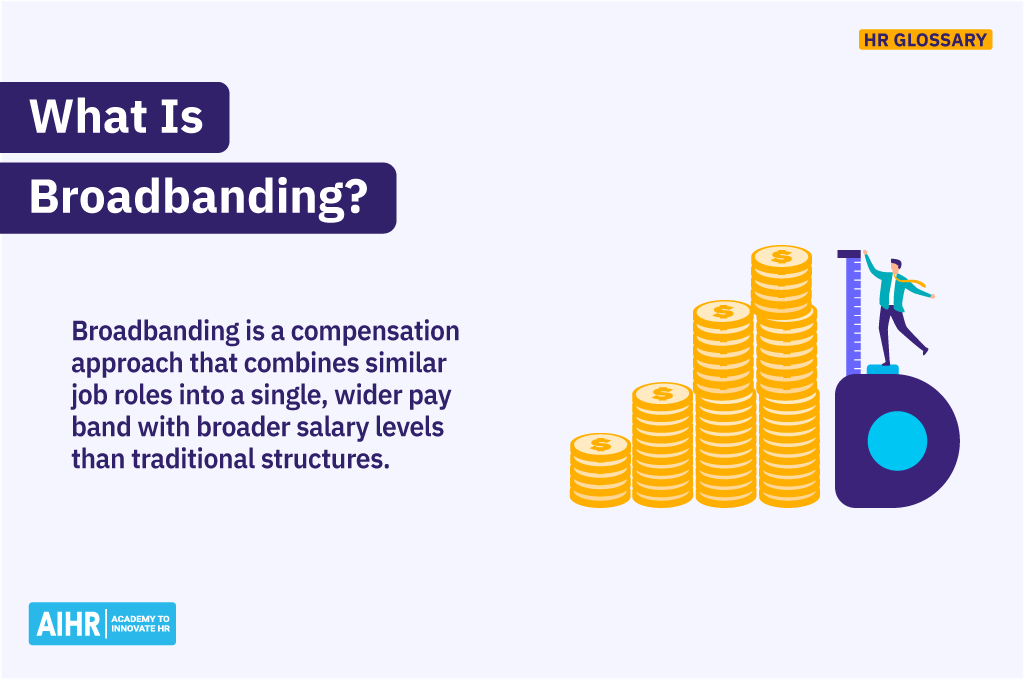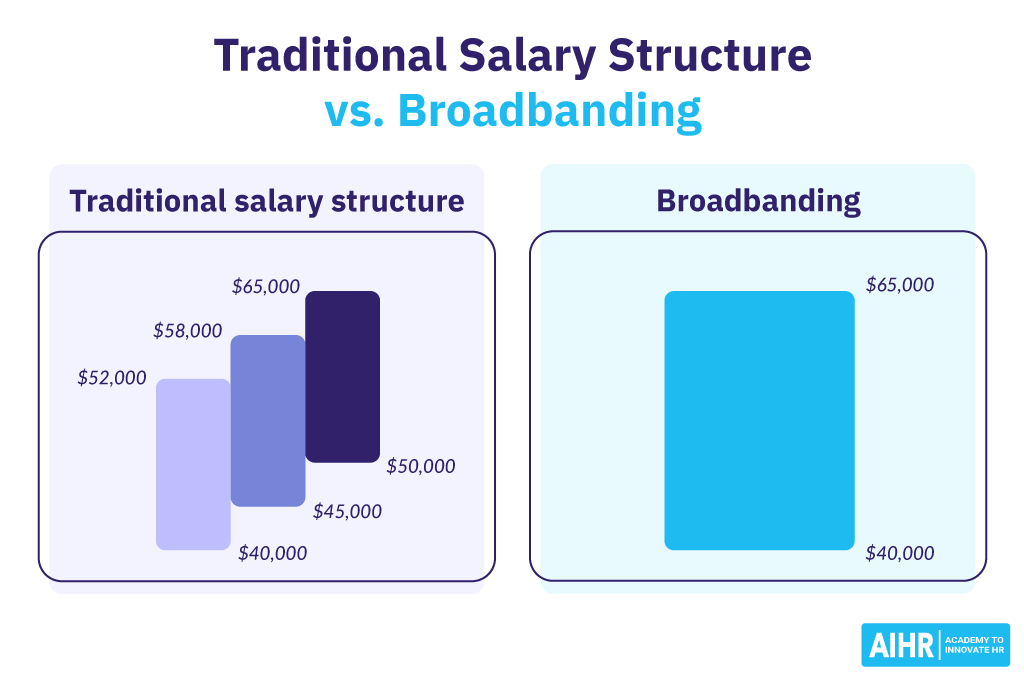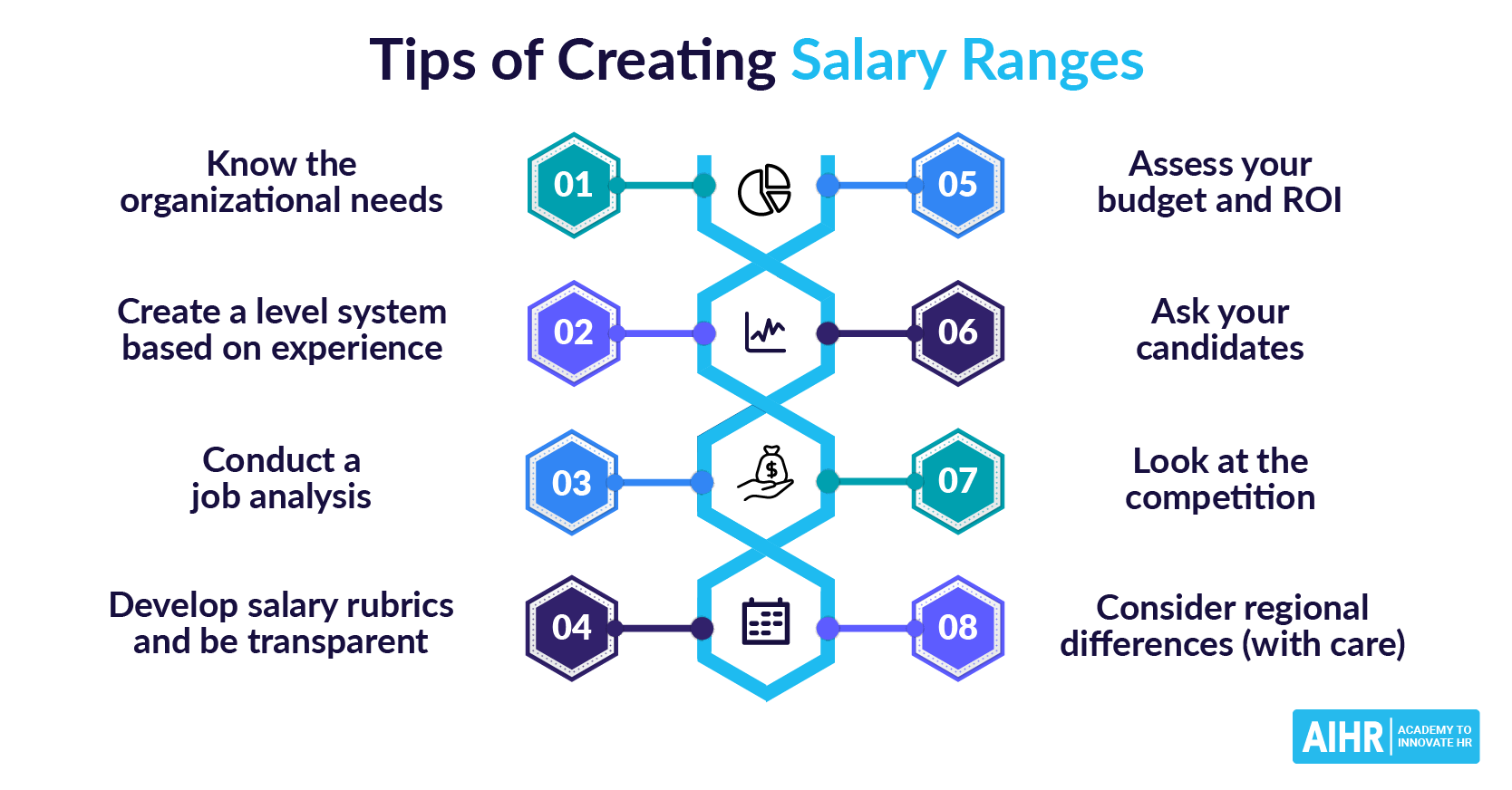Broadbanding
What is broadbanding?
Broadbanding is a compensation approach that consolidates a range of similar job classifications into a single pay band. This encompasses a much broader range of compensation levels than traditional salary structures and results in reducing the number of pay grades.
A traditional salary band usually has a range spread of 25% to 60% in its single-step grade structure, whereas a broadband structure often has an 80% to 300% from the low-end to high-end scales.
A broadband approach gives management a wider range and flexibility when it comes to paying employees.

What are the objectives of broadbanding?
HR, along with compensation and benefits teams, implement broadbanding with the following objectives in mind:
- Offering flexibility in employee compensation
- Encouraging employees to acquire new skills to move higher within the pay range
- Reducing the need for pay band reclassification.
Who uses broadbanding?
Broadbanding is more common in industries where employees tend to stay within the same companies and expand on their skills and training to move up within the same band. In other words, broadbanding makes it easier to reward employees for horizontal career growth.
Broadbanding can work well for the following types of organizations:
- Healthcare and hospitals
- Startups
- IT
On the other hand, highly hierarchical organizations require different pay structures, as broadbanding de-emphasizes hierarchy. This type of pay structure might also be unsuitable for scaling companies, as it is not easy to replicate across different locations.
Traditional salary structure vs. broadbanding
Here’s a breakdown of the traditional salary structure versus broadbanding:
Number of pay grades
Many narrow pay grades for specific roles
Fewer, wider pay bands covering multiple roles
Flexibility
Less flexible, tied to job titles and promotions
More flexible, allows pay adjustments without title changes
Career progression
Relies on promotions for salary increases
Encourages lateral movement and skill development
Salary range width
Narrow salary ranges for each grade
Wide salary bands with greater pay variation
Managerial discretion
Limited discretion in adjusting pay
More discretion to adjust pay based on performance or market conditions

An example of broadbanding
Let’s say a company has a traditional salary structure with several levels of administrative positions, such as Administrative Assistant I, Administrative Assistant II, and Administrative Assistant III. Each position has a narrow annual salary range; for example:
- Administrative Assistant I: $35,000 – $40,000
- Administrative Assistant II: $40,000 – $45,000
- Administrative Assistant III: $45,000 – $50,000
In a broadbanding system, these three roles would be grouped into a single, broader salary band. For instance, the company might create an “Administrative Support” band with a salary range of $35,000 – $50,000.
Within this broader band, employees could earn raises based on skills, performance, or market conditions, without necessarily needing a promotion to a new title. This allows for greater flexibility in managing compensation, as employees could advance within the same band without the need for a formal title change or reclassification.
For example, an Administrative Assistant I who gains experience and takes on additional responsibilities might see their salary increase within the band, even if their title remains the same. This helps retain talent and motivate growth without requiring constant promotions.
Advantages and disadvantages of broadbanding
The advantages
- It encourages internal mobility and lateral moves within the organization. Being likely to stay in a specific pay band for longer can push employees to take on new projects, learn new skills, and take on stretch tasks to receive a pay increase. Focusing on competencies and skills rather than on job titles also promotes continuous learning and development.
- It streamlines organizational hierarchy by reducing the number of levels in a company and creating space for lateral moves and horizontal career growth.
- It increases employee satisfaction, especially for deep specialists. As such, they don’t need a promotion to advance in their careers and can achieve pay progression without having to become managers.
- It’s easier to administer. It is flexible and improves managers’ ability to reward their employees without needing to promote them to provide more financial incentives continuously.
The disadvantages
- It does not always account for external salary benchmarks and changes in external market conditions.
- It reduces promotion opportunities. Broadbanding might contradict the work culture in some countries, where employees tend to expect promotions more frequently than in other countries. Fewer promotion opportunities may also cause employees to lose motivation.
- It can create (the perception of) pay inequity among employees. If you don’t set clear rules for rewarding similar work equally, broadbanding can result in pay differences that are difficult to justify.
How to move from traditional salary ranges to broadbanding
Here are the key elements you need to successfully implement broadbanding in your organization:
- Review your current compensation structure: Evaluate your company’s existing pay policies and strategies to determine how to transition to a broadbanding pay structure.
- Make sure your job evaluation system is credible: This should happen before you implement broadbanding to ensure fair and accurate job classification into bands.
- Put jobs of equal value in one band: This ensures consistency and fairness. External auditors also regularly verify bands, so documenting them clearly is important.
- Involve all relevant stakeholders: The compensation and benefits team should involve HR, management, and even employees when developing the bands. Communication is key, and explaining a broadband structure is easier when more people are involved in its creation.
- Develop clear policies around your broadbanding structure: This policy should include information on how employees can earn a raise within their pay band, how moving from one broadband to another works, etc.
Broadbanding in HR: What to keep in mind
Explain the broadbanding pay structure in the selection and interview process to help you manage employee expectations about pay increases and career growth within your organization from the very beginning of the employee life cycle.
FAQ
Broadbanding is a compensation strategy that consolidates multiple pay grades into fewer, wider salary bands. This allows for more flexibility in employee pay, making it easier to reward skills, experience, and performance without needing frequent promotions. It’s commonly used to support career development and simplify the structure of pay grades.
An example of broadbanding would be a company with traditional pay grades for junior, mid-level, and senior roles combining those into a single, broader salary band. For instance, instead of having separate pay ranges for an entry-level marketing associate, a marketing manager, and a senior marketing manager, the company could use one wide band to cover all three roles. This gives employees more room to grow within the band without needing a formal title change.









